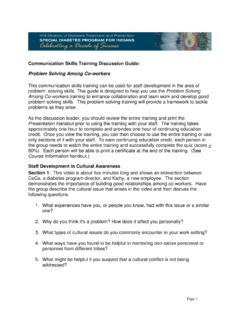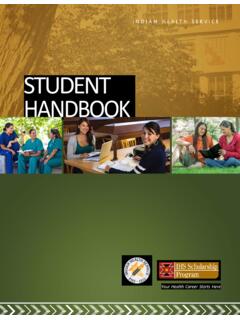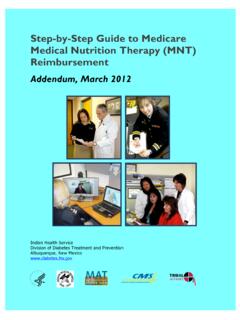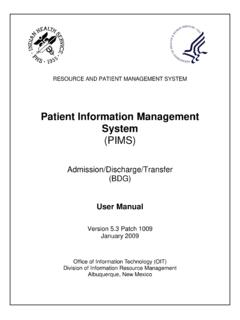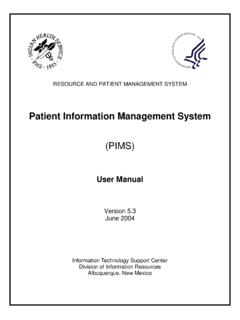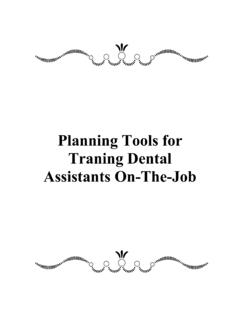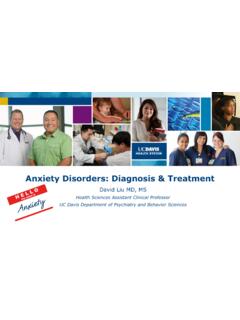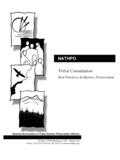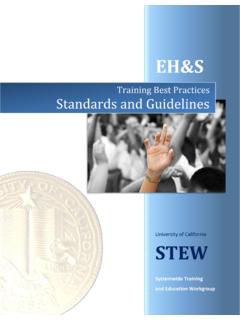Transcription of Oral Health Best Practices - Indian Health Service (IHS)
1 oral Health for Head Start Children: best Practices Just the Facts Early Childhood Caries (ECC) is the single most common chronic disease of childhood, occurring at least five times more frequently than asthma, the second most common chronic disease of childhood. American Indian and Alaska Native (AI/AN) children experience dental caries at a higher rate than the general population. Data from 7,571 children ages 2-5 years documented that 62 percent had experienced dental caries (filled or unfilled decay) and 44 percent had untreated dental caries. By two years of age, 44 percent of AI/AN children already had cavities, supporting the fact that prevention interventions must be implemented with pregnant women and infants. In order to prevent dental caries in the primary teeth, we must intervene before the first cavity develops, working with both mothers and infants. For children in Head Start, we want to prevent future decay in the erupting permanent teeth.
2 Dental Caries is an infectious, transmissible disease caused by mutans streptococci, lactobacilli, and other acid-producing bacteria. The bacteria that cause tooth decay are fueled by sweet foods and drinks and other fermentable carbohydrates like white crackers. Over time, the enamel breaks down, resulting first in a chalky white spot that then progresses to a cavity. Severe ECC causes pain and infection. ECC can also result in poor self-esteem and a reluctance to smile. The primary teeth are important for eating, holding space for the permanent teeth, talking, and smiling. Severe ECC can cost from $2,000-$8,000 or more per child to treat. Some of these children need to be hospitalized, and treatment may need to be completed under general anesthesia. ECC places a huge financial burden on insurance, Medicaid, Indian Health Service , Tribal programs, and families least able to afford treatment. Dental treatment does not remove the disease-causing bacteria.
3 Even after treatment, the disease rages on for high-risk children. No child can be truly healthy if he or she has poor oral Health . 1 oral Health for Head Start Children: best Practices Introduction Early Childhood Caries (ECC) is a term used to describe tooth decay, including filled or extracted teeth due to decay, in the primary teeth (baby teeth). Other names for this disease are Baby Bottle Tooth Decay (BBTD), nursing mouth, and bottle rot. Severe ECC is characterized by a distinctive pattern of tooth decay in infants and young children, often beginning on the upper front teeth and rapidly progressing to the other primary teeth as they erupt. ECC is an infectious, transmissible disease caused by mutans streptococci, lactobacilli, and other acid-producing bacteria. While the transmission is primarily vertical between mothers or other primary caregivers and infants, studies have also demonstrated horizontal transmission from infants to infants, as well as from older children to infants.
4 We now know that the organisms that cause dental caries can begin to colonize in the mouth of an infant even before the eruption of teeth. The bacteria that cause tooth decay produce acids from carbohydrates. The bacteria are fueled by sweet foods and drinks and other fermentable carbohydrates. Over time, the enamel demineralizes, resulting first in a chalky white spot that then progresses to a cavity. It is important to rethink the way we treat dental caries. Traditionally, we would wait until a child had a cavity and treat the cavity with a filling. In order to prevent ECC, we must intervene before the first cavity develops, working with both mothers and infants. Problem Statement American Indian and Alaska Native (AI/AN) children experience dental caries at a higher rate than the general population. Data from 7,571 children ages 2-5 years documented that 62 percent had experienced dental caries (filled or unfilled decay) and 44 percent had untreated dental caries.
5 * By two years of age, 44 percent of AI/AN children already had cavities, supporting the fact that prevention interventions must be implemented with pregnant women and infants. Severe ECC causes pain and infection. Many of these children learn to live with this pain day in and day out. ECC results in increased missed school days and an inability to concentrate at school. Pain also affects a child s sleep and nutrition, resulting in poor overall Health and well being. ECC can also result in poor self-esteem and a reluctance to smile. The primary teeth are important for eating, holding space for the permanent teeth, talking, and smiling. We can no longer ignore this infection until a child is 3-4 years old, any more than we would ignore any other infection that a child might have. *Phipps KR, Ricks TL, Manz MC, Blahut P, Prevalance and severity of dental caries among American Indian and Alaska Native preschool children, J Public Health Dent. 72:208-15, Summer 2012.
6 2 oral Health for Head Start Children: best Practices best Practices During Pregnancy COLLABORATE! Collaborate with the medical, community Health , and dental providers to assure that all pregnant women visit the dental clinic during the early months of pregnancy. EDUCATE! Educate the mother about the transmissibility of dental caries and ways to prevent ECC. Provide education and support to promote breastfeeding. COUNSEL! Provide nutrition counseling to reinforce the importance of a healthy diet during the perinatal period. MAKE RECOMMENDATIONS! Recommend that pregnant women stop using tobacco. SET AN APPOINTMENT! The dental staff can provide an exam, prophylaxis, recommendations for completing any needed dental treatment, caries control, and appropriate recall. The dental staff can assess the mother s caries risk and make appropriate prevention recommendations. Why? Pregnant women should get their teeth cleaned and checked early in their pregnancy.
7 Gum disease has been linked to premature low birth-weight babies. The caries risk assessment gives you the opportunity to assess whether the baby will be at high risk for future dental caries and also provides an opportunity to educate the mother about ways to prevent ECC. How? Collaborate between the medical, community Health , and dental providers to assure that all pregnant women visit the dental clinic during the early months of pregnancy. Head Start, WIC, and other tribal Health programs that serve pregnant women can also participate as partners to encourage pregnant women to visit the dentist. The following list of recommendations for education should be reinforced by the various medical providers, dental staff, community Health workers, and other partners as identified in each community. Refer all pregnant women to the dental clinic during the early months of pregnancy. Educate the mother about the transmissibility of dental caries and ways to prevent ECC.
8 Reinforce the importance of a healthy diet and limited snacking on pop, sweets, and starchy snacks like potato chips and white crackers because. It is also important to get plenty of calcium for baby s teeth and bones. It is found in milk, cheese, dried beans, and leafy green vegetables. Support breastfeeding at every opportunity. Educate the mother about gum disease as it relates to the Health of her baby. Recommend and demonstrate daily brushing with fluoride toothpaste and flossing or other methods to clean in between the teeth and gums. Recommend that pregnant women stop using tobacco. It is unhealthy for both baby and mother and it also is a contributing factor in gum disease. 3 oral Health for Head Start Children: best Practices best Practices During Pregnancy Glossary ECC: Early Childhood The dental staff can provide an oral exam, periodontal disease Caries, previously called screening, prophylaxis, recommendations for completing any Baby Bottle Tooth Decay.
9 Needed dental treatment, caries control, and appropriate recall. This term refers to dental decay on the primary, or The dental staff can assess the woman s caries risk and work with baby teeth. the mother to establish an effective and appropriate caries control program. Primary Teeth: Baby Teeth Dental Caries: The disease process that The New York State Department of Health has developed a leads to cavities, or tooth manual oral Health Care During Pregnancy and Early Childhood: decay. Practice Guidelines It is located at Prophylaxis: Procedures to clean the teeth of plaque, calculus, and stain. Perinatal: As used in this document, it refers to the period of time during pregnancy and one year after birth. Note: Education alone is not a best practice. Effective Health education includes motivational interviewing, demonstrations, and reinforcement. Supporting Articles: Xiong X, et al Periodontal disease and adverse pregnancy outcomes: a systematic review, International J of Obstetrics and Gynecology, Oct 2005.
10 Kanellis MJ. Caries risk assessment and prevention: strategies for Head Start, Early Head Start and WIC. J Public Health Dent. 60(3):210-17, discussion 218-20, 2000 4 oral Health for Head Start Children: best Practices best Practices : Birth Through Two Years RECOMMENDATIONS: Why? ASSESS! By two years of age, most AI/AN children already have decay in their baby teeth. To prevent this disease, we must intervene Provide an oral Health soon after the first tooth erupts. An infant oral Health assessment soon after the first assessment is recommended by the American Dental tooth erupts or by 12 months Association, American Association of Pediatric Dentists, of age. American Public Health Association, and the American Academy of Pediatrics. PREVENT! Fluoride varnish is a safe, effective method to provide topical fluoride treatments to infants and toddlers. Fluoride works by Provide topical fluoride varnish inhibiting demineralization, enhancing remineralization, and treatments 4 or more times inhibiting plaque bacteria.
